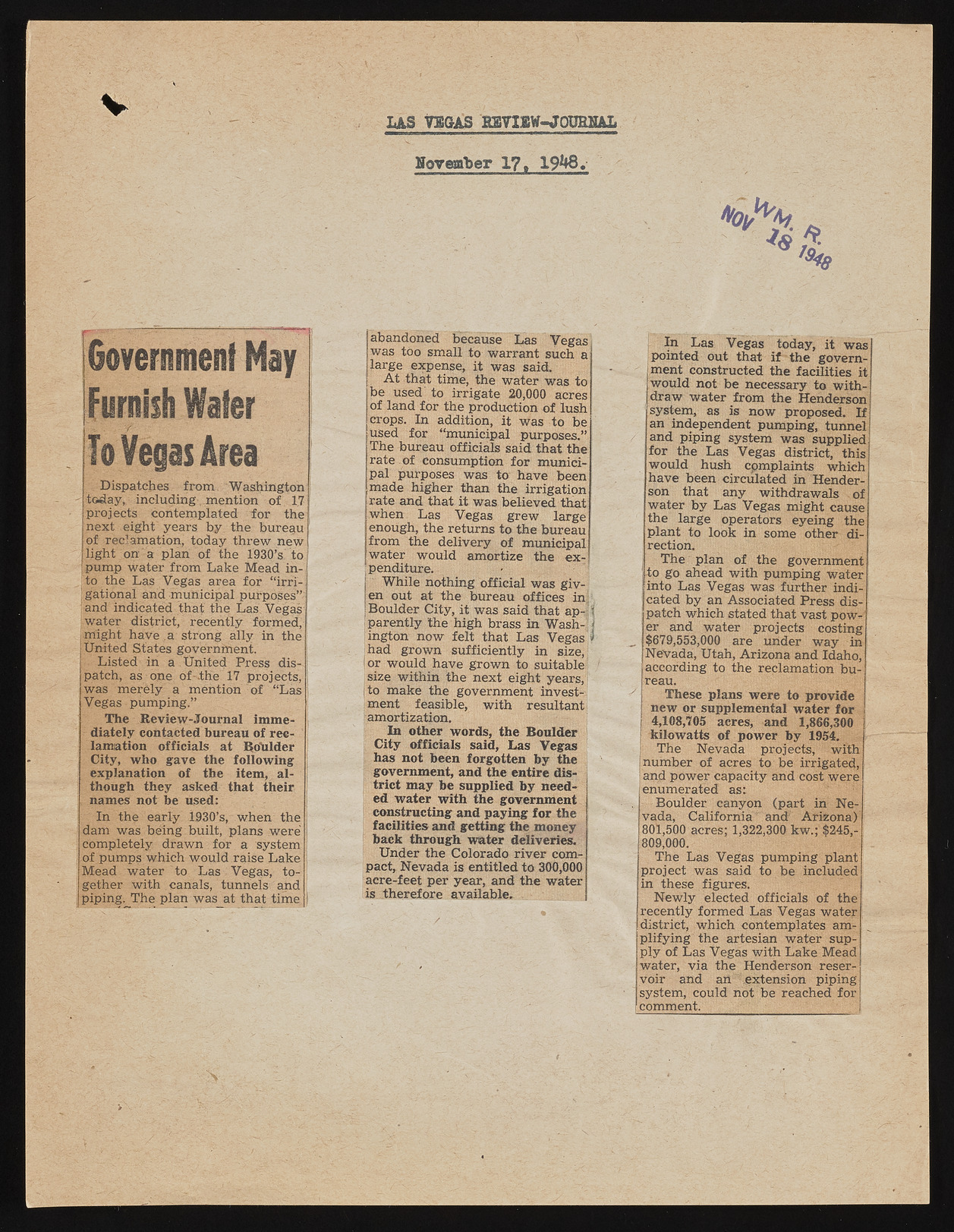Copyright & Fair-use Agreement
UNLV Special Collections provides copies of materials to facilitate private study, scholarship, or research. Material not in the public domain may be used according to fair use of copyrighted materials as defined by copyright law. Please cite us.
Please note that UNLV may not own the copyright to these materials and cannot provide permission to publish or distribute materials when UNLV is not the copyright holder. The user is solely responsible for determining the copyright status of materials and obtaining permission to use material from the copyright holder and for determining whether any permissions relating to any other rights are necessary for the intended use, and for obtaining all required permissions beyond that allowed by fair use.
Read more about our reproduction and use policy.
I agree.Information
Digital ID
Permalink
Details
More Info
Rights
Digital Provenance
Publisher
Transcription
Government May Furnish Water To Vegas Area Dispatches from, Washington - today, including. mention of 17 projects contemplated for the next eight years by the bureau of reclamation, today threw new •light on a plan of the 1930’s to| pump water from Lake Mead into the Las Vegas area for “irri-gational and municipal purposes” jand indicated that the Las Vegas' ; water district, recently formed, might have a strong ally in the United States government, Listed in a United Press dispatch, as one of .the 17 projects, was merely a mention of “Las Vegas pumping.” The Review-Journal imme- | diately contacted bureau of ree- ‘ | lamia tion officials at Rotilder City, who gave the following j explanation of the item, al- , though they asked that their j names not be used: In the early 1930’s, when the dam was being built, plans were ! completely drawn for a system of pumps which would raise Lake | Mead water to Las Vegas, to- i gether with canals, tunnels and ? piping. The plan was_at that time ) IAS VEGAS KBVIEW-JOUEHAL November 17, 19^8* abandoned because Las Vegas j was too small to warrant such a large expense, it was said. At that time, the water was to be used to irrigate 20,000 acres of land for the production of lush crops. In addition, it was to be used for “municipal purposes.” The bureau officials said that the rate of consumption for municipal purposes was to have been made higher than the irrigation rate and that it was believed that when Las Vegas grew large enough, the returns to the bureau from the delivery of municipal water would amortize the expenditure. ? While nothing official was giv-ien out at the bureau offices in; | Boulder City, it was said that ap-; 1 parently the high brass in Wash- j jington now felt that Las Vegas » I had grown sufficiently in size,! I or would have grown to suitable size within the next eight years,; I to make the government invest- , iment feasible, with resultant! amortization. In other words, the Boulder City officials said, Las Vegas : has not been forgotten by the government, and the entire dis- j trict may be supplied by needed w ater w ith the government constructing and paying for the facilities and getting the money back through w ater deliveries. Under the Colorado river compact, Nevada is entitled to 300,000 acre-feet per year, and the water is therefore available. In Las Vegas today, it was jpointed out that if the governm ent constructed the facilities it (would not be necessary to withdraw water from the Henderson system, as is now proposed. If an independent pumping, tunnel and piping system was supplied for the Las Vegas district, this would hush cpmplaints which have been circulated in Henderson that any withdrawals of water by Las Vegas might cause the large operators eyeing the plant to look in some other direction. ; The plan of the government j to go ahead with pumping water into Las Vegas was further indicated by an Associated Press dispatch which stated that vast power and water projects costing _ $679,553,000 are under way in Nevada, Utah, Arizona and Idaho, according to the reclamation bureau. y f These plans were to provide new or supplemental w ater for I 4,108,705 acres, and 1,866,300 kilowatts of power by 1954. The Nevada projects, with number of acres to be irrigated, and power capacity arid cost were enumerated as: Boulder canyon (part in Nevada, California" and' Arizona) 801,500 acres; 1,322,300 kw.; $245,- (809,000. The Las Vegas pumping plant project was said to be included in these figures. Newly elected officials of the recently formed Las Vegas water district, which contemplates amplifying the artesian water supply of Las Vegas with Lake Mead water, via the Henderson reservoir and an extension piping system, could not be reached for comment.

